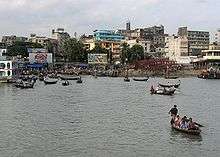Buriganga River
| Buriganga River | |
| A launch sails from Sadarghat on the Buriganga. | |
| Country | Bangladesh |
|---|---|
| City | Dhaka |
| Source | Dhaleshwari River |
| - location | near Kalatia [1]
|
| Mouth | Dhaleshwari River |
| - location | about 3 km (2 mi) southwest of Fatullah [1]
|
| Length | 18 km (11 mi) [1] |
 | |
The Buriganga River (Bengali: বুড়িগঙ্গা Buŗigônga "Old Ganges") flows past the southwest outskirts of Dhaka city, the capital of Bangladesh. Its average depth is 7.6 metres (25 ft) and its maximum depth is 18 metres (58 ft).
History
.jpg)
In the distant past, a course of the Ganges river used to reach the Bay of Bengal through the Dhaleshwari river. When this course gradually shifted and ultimately lost its link with the main channel of the Ganges it was renamed the Buriganga. It is said that the water levels during high and very high tides in this river astonished the Mughals. In the 20th century the water table and river became polluted by polythenes and other hazardous substances from demolished buildings near the river banks.
The course of the Padma, as the main course of the Ganges is known in Bangladesh, changed considerably during the period 1600 to 2000 AD. It is difficult to trace accurately the various channels through which it flowed, but the probability is that it flowed past Rampur Boalia, through Chalan Beel, the Dhaleshwari and Buriganga rivers, past Dhaka into the Meghna estuary. In the 18th century, the lower course of the river flowed further south. About the middle of the 19th century the main volume of the channel flowed through this southern channel, which came to be known as Kirtinasa. Gradually the Padma adopted its present course.[2]
Pollution
The Buriganga is economically very important to Dhaka. Launches and country boats provide connection to other parts of Bangladesh, a largely riverine country. When the Mughals made Dhaka their capital in 1610, the banks of the Buriganga were already a prime location for trade. The river was also the city's main source of drinking water.
Today, the Buriganga river is afflicted by the noisome problem of pollution. The chemical waste of mills and factories, household waste, medical waste, sewage, dead animals, plastics, and oil are some of the Buriganga's pollutants. The city of Dhaka discharges about 4,500 tons of solid waste every day and most of it is released into the Buriganga. According to the Department of the Environment (DoE), 22,000 litres (5,800 US gal) of toxic waste are released into the river by the tanneries every day.[3] Experts identified nine industrial areas in and around the capital city as the primary sources of river pollution: Tongi, Tejgaon, Hazaribagh, Tarabo, Narayanganj, Savar, Gazipur, Dhaka Export Processing Zone and Ghorashal. Most of the industrial units of these areas have no sewage treatment or effluent treatment plants (ETPs) of their own.

More than 60,000 cubic metres (2,100,000 cu ft) of toxic waste, including textile dying, printing, washing and pharmaceuticals, are released into the main water bodies of Dhaka every day. According to the Dhaka Water and Sewerage Authority (WASA), about 12,000 cubic metres (420,000 cu ft) of untreated waste are released into the lake from Tejgaon, Badda and Mohakhali industrial areas every day. The waste mostly comes from garment washing and dyeing plants. Textile industries annually discharge as much as 56 million tonnes of waste and 0.5 million tonnes of sludge. Sewage is also released into the Buriganga. A newspaper article from 2004[4] indicated that up to 80% of Dhaka's sewage was untreated. Because of Dhaka's heavy reliance on river transport for goods, including food, the Buriganga receives especially high amounts of food waste since unusable or rotting portions of fruits, vegetables, and fish are thrown into the river.
Nearly 4.0 million people of the city are exposed to the consequences of water pollution every day.
Previously, a group of environmentalists attempted to form a river patrolling team to save the Buriganga and other rivers from extreme pollution. The group was concerned about the contamination of the rivers around the capital and demanded immediate action. The government has been criticized for its inability or unwillingness to stop the industrial units of the city from releasing untreated waste into the water.
Gallery
- Large launches waiting at Sadarghat on the Buriganga for different destinations in Bangladesh
- A boatman sells pineapples at Sadarghat on the Buriganga
 Sadarghat port on the Buriganga River, Dhaka city
Sadarghat port on the Buriganga River, Dhaka city Sadarghat port on the Buriganga river is an important river transport hub
Sadarghat port on the Buriganga river is an important river transport hub- Small boats ply on the Buriganga at Sadarghat
- Land reclamation on the Buriganga river dredges sand and deposits it on the floodplain.
 A wonderful view of Buriganga River, Dhaka, Bangladesh
A wonderful view of Buriganga River, Dhaka, Bangladesh Evening of Buriganga River, Dhaka, Bangladesh
Evening of Buriganga River, Dhaka, Bangladesh
References
- 1 2 3 "Burigunga River". Burigunga Riverkeeper. Retrieved 13 October 2014.
- ↑ Majumdar, Dr. R.C., History of Ancient Bengal, First published 1971, Reprint 2005, pp. 3-4, Tulshi Prakashani, Kolkata, ISBN 81-89118-01-3.
- ↑ Brady, Tara (24 March 2014). "Working themselves to death, the Bangladesh men and women tanning leather for a pittance in one of the world's top 30 most polluted locations". Daily Mail. Retrieved 24 March 2014.
- ↑ "Dhaka's looming water crisis". The Financial Express (Editorial). Dhaka. Archived from the original on 10 March 2005.
External links
- Chowdhury, Sifatul Quader (2012). "Buriganga River". In Islam, Sirajul; Jamal, Ahmed A. Banglapedia: National Encyclopedia of Bangladesh (Second ed.). Asiatic Society of Bangladesh.
Coordinates: 23°38′N 90°26′E / 23.633°N 90.433°E